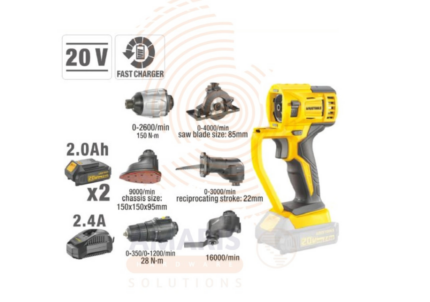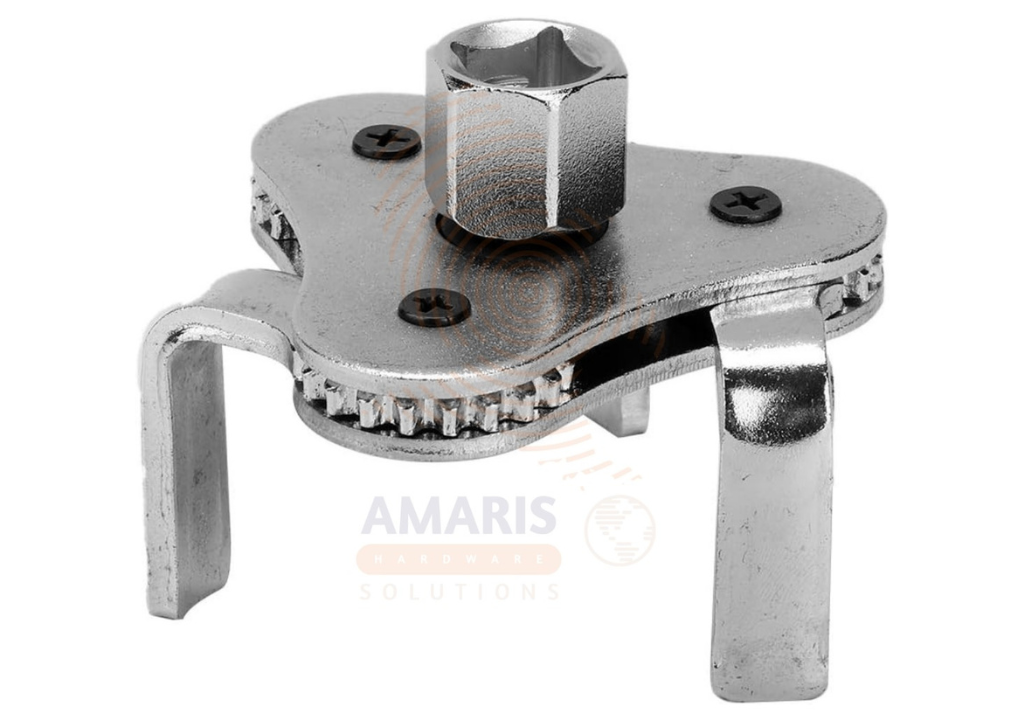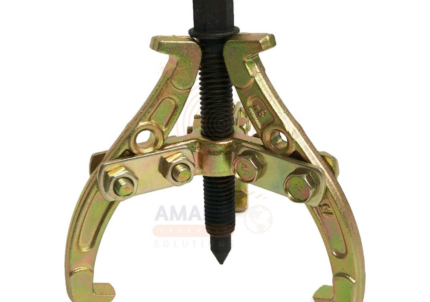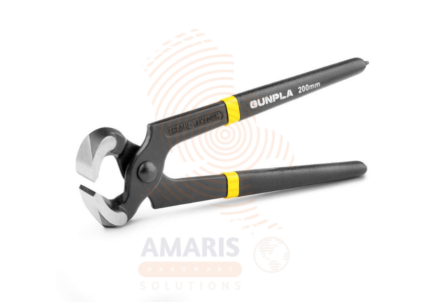Back to products


6 in 1 Cordless Multi Tool
$206.70 Original price was: $206.70.$202.57Current price is: $202.57.
3-Jaw Oil Filter Wrench
WhatsApp Order
A 3-jaw oil filter wrench is a tool designed for the purpose of gripping and removing automotive oil filters with three adjustable jaws. The wrench typically features a three-pronged mechanism that can be adjusted to fit different sizes of oil filters securely. This design allows for a firm grip on the filter housing, making it easier to loosen and remove the oil filter during routine maintenance or when changing the oil in a vehicle. The three jaws provide a balanced and stable grip, minimizing the risk of slippage and ensuring efficient filter removal.
Categories: AUTOMOTIVE TOOLS & ACCESSORIES, Automotive Wrenches & Socket Sets, HAND TOOLS, Wrenches & Spanners
Tags: 3-jaw oil filter wrench, adjustable filter wrench, automotive tool, durable filter wrench, hand tools, mechanic wrench, oil change tool, oil filter removal tool, precision oil filter tool
Description
Table of Contents
Toggle3-Jaw Oil Filter Wrench
Uses
-
Oil Filter Replacement: The primary purpose of a 3-jaw oil filter wrench is to facilitate the removal and installation of oil filters during routine oil changes. The adjustable jaws can accommodate different sizes of oil filter housings, providing a secure grip for easy removal.
-
Automotive Maintenance: The tool is widely used in automotive maintenance and repair shops for tasks related to oil filter replacement. Mechanics and car enthusiasts use it to quickly and efficiently remove old oil filters and install new ones.
-
DIY Oil Changes: Individuals performing their own oil changes on cars or motorcycles often use a 3-jaw oil filter wrench. The adjustable nature of the wrench allows it to fit various filter sizes, making it a handy tool for do-it-yourself (DIY) enthusiasts.
-
Fleet Maintenance: In the context of fleet management, where multiple vehicles are maintained, 3-jaw oil filter wrenches are valuable tools for the efficient and standardized replacement of oil filters across different vehicle types.
-
Emergency Repairs: In emergency situations where a damaged or leaking oil filter needs to be replaced quickly, a 3-jaw oil filter wrench can be instrumental in removing the old filter and installing a new one promptly.
-
Heavy Machinery Maintenance: Beyond automotive applications, these wrenches can also be used in the maintenance of heavy machinery and equipment that utilize oil filters. The adjustable jaws make them adaptable to different filter sizes commonly found in various industrial applications.
-
Versatile Gripping Tool: The 3-jaw design allows for a secure grip on cylindrical objects other than oil filters. In some cases, people use these wrenches for tasks where a strong, adjustable grip is needed, such as loosening or tightening other types of round or cylindrical components.
SAFETY HANDLING PRECAUTIONS
Safety Precautions
-
Wear Personal Protective Equipment (PPE): Always wear appropriate personal protective equipment, such as gloves and safety glasses, to protect yourself from cuts, abrasions, and any potential flying debris.
-
Inspect the Wrench: Before using the 3-jaw oil filter wrench, inspect it for any signs of damage, wear, or malfunction. Ensure that the jaws are in good condition and that the adjusting mechanism works properly.
-
Choose the Right Size: Select the appropriate size of the wrench for the oil filter you are working on. Using the wrong size may lead to slippage or damage to the filter, the wrench, or both.
-
Proper Adjustment: Adjust the jaws of the wrench to fit the oil filter snugly. A secure fit reduces the risk of slippage during use. Avoid overtightening, as this can damage the filter or the wrench.
-
Positioning: Position the wrench correctly on the oil filter before applying force. Make sure the wrench is aligned properly to prevent it from slipping off during use.
-
Stability: Ensure that the vehicle is on a stable and level surface before attempting to use the wrench. This helps prevent accidents and provides a more secure working environment.
-
Secure the Vehicle: If possible, engage the parking brake and use wheel chocks to prevent the vehicle from rolling. This adds an extra layer of safety, especially when working on an inclined surface.
-
Turn in the Right Direction: When using the wrench to remove the oil filter, make sure you are turning it in the correct direction. Some filters unscrew in a clockwise direction, while others unscrew counterclockwise. Consult the vehicle's manual if you are unsure.
-
Apply Even Pressure: When turning the wrench, apply even and steady pressure. Avoid sudden or jerky movements, as this can lead to loss of control and potential injury.
-
Be Mindful of Hot Surfaces: If you are working on a recently driven vehicle, be cautious of hot surfaces, including the oil filter. Allow the engine to cool down before attempting to remove the oil filter.
-
Dispose of Used Filters Properly: After removing the oil filter, dispose of it according to local regulations. Used oil filters may contain residual oil, so handle them with care and dispose of them in an environmentally responsible manner.
Related products
Carpenter’s Pincers
Carpenter's pincers, also known as end-cutting pliers or end nippers, are a type of hand tool used in carpentry and woodworking. They typically have sharp, pointed jaws that come together in a cutting edge at the tips. These pincers are designed for gripping, cutting, and pulling materials such as nails, wires, or small objects in woodworking applications. The jaws are angled to provide leverage and facilitate precise cutting or gripping in tight spaces. Carpenter's pincers are a versatile tool commonly found in a carpenter's toolkit for various tasks related to shaping and assembling wood.
Combination spanner set
A combination spanner set typically refers to a collection of twelve different-sized spanners that feature both open-end and box-end configurations. Combination spanners are versatile tools commonly used in mechanical and household applications. The open end is designed to grip fasteners in tight spaces, while the box end provides a more secure grip on the flats of a nut or bolt.
The set usually includes a range of sizes to accommodate various fastener dimensions. Each spanner in the set may be marked with its specific size, typically in metric or imperial units. This versatile tool set is essential for tasks that require tightening or loosening nuts and bolts in different applications, providing flexibility and convenience for the user.
Fiberglass Open Reel Long Tape Rule
PRODUCT DESCRIPTION
A Fiberglass Open Reel Long Tape is a measuring tool designed for accurately determining distances in various applications, such as construction, surveying, and landscaping. It typically consists of a durable, flexible fiberglass tape housed on an open reel. The fiberglass material provides strength and resistance to stretching, ensuring precise measurements over extended lengths. The open reel design allows for easy deployment and retraction of the tape, facilitating efficient use in outdoor and large-scale measurement scenarios. These tapes often feature clear and legible markings, making them suitable for both personal and professional use in situations where accurate and reliable distance measurements are essential.
Flat Cold Chisel with Guard
PRODUCT DESCRIPTION
A flat cold chisel with a guard is a hand tool designed for cutting, shaping, or removing metal by striking it with a hammer. The chisel has a flat, elongated metal blade with a sharp cutting edge at one end. The guard, often made of metal or another protective material, is positioned along the sides of the blade to enhance safety during use. This guard helps prevent accidental injuries by shielding the user's hand from direct contact with the sharp edge and also provides stability to the chisel during striking. The flat cold chisel with a guard is commonly used in metalworking and construction applications.
Flat Hand Steel File
PRODUCT DESCRIPTION
A flat hand file is a type of hand tool used in metalworking and woodworking to remove material from a workpiece by abrasion. It consists of a flat, elongated piece of metal with parallel rows of teeth or ridges, called the file's "cut," which are designed to cut or shape a material when rubbed against it. Flat hand files are typically rectangular in shape and come in various sizes and coarseness grades, allowing for different levels of material removal and finishing. These files are commonly used for smoothing, shaping, and leveling surfaces in a variety of applications, providing a versatile means of material removal in manual craftsmanship.
Flat Screwdriver
PRODUCT DESCRIPTION
A flat screwdriver, also known as a slotted screwdriver, is a hand tool designed for turning screws with a slotted (flat) head. It typically features a flat, narrow, and straight metal blade, with a handle at one end for gripping and rotating the tool. The blade is inserted into the corresponding slot in the screw head, and by applying torque to the handle, the screwdriver allows for the tightening or loosening of the screw. Flat screwdrivers are commonly used in various manual and mechanical applications for tasks such as assembling furniture, fixing appliances, and general household repairs.
Flat Wood File
PRODUCT DESCRIPTION
A flat wood file is a hand tool used for shaping, smoothing, and refining the surfaces of wood. It typically consists of a flat, narrow, rectangular piece of metal with a series of parallel, coarse teeth or ridges along one or both of its sides. These teeth are designed to efficiently remove material when drawn across the wood grain, allowing for the leveling and smoothing of wooden surfaces. Flat wood files are commonly used in woodworking and carpentry for tasks such as shaping edges, refining contours, and removing rough spots on wood surfaces.
Folding Saw
PRODUCT DESCRIPTION
A folding saw is a compact and portable cutting tool designed for outdoor and survival activities. It typically features a serrated blade that folds into a handle, allowing for safe and convenient storage when not in use. Folding saws are commonly used for cutting through wood, branches, or other vegetation during camping, hiking, and various outdoor adventures. The folding design enhances portability and safety, making it a versatile tool for enthusiasts and professionals alike.


 Acrylic Sealants
Acrylic Sealants Construction Adhesives
Construction Adhesives Double-Sided Tape
Double-Sided Tape Duct Tape
Duct Tape Electrical Tape
Electrical Tape Epoxy & Resins
Epoxy & Resins Masking Tape
Masking Tape
 Automotive Wrenches & Socket Sets
Automotive Wrenches & Socket Sets Battery Chargers & Jump Starters
Battery Chargers & Jump Starters Car Jacks & Stands
Car Jacks & Stands Car Wash & Detailing Products
Car Wash & Detailing Products Diagnostic Tools
Diagnostic Tools Tire Inflators
Tire Inflators Vehicle Lighting
Vehicle Lighting Oil & Lubricants
Oil & Lubricants
 Adhesives & Sealants
Adhesives & Sealants Bricks & Blocks
Bricks & Blocks Cement & Concrete
Cement & Concrete Drywall & Plaster
Drywall & Plaster Flooring (Tiles, Wood, Laminate)
Flooring (Tiles, Wood, Laminate) Lumber & Plywood
Lumber & Plywood Paints, Primers & Coatings
Paints, Primers & Coatings Insulation Materials
Insulation Materials Roofing Materials
Roofing Materials
 Circuit Breakers
Circuit Breakers Electrical Cables & Wires
Electrical Cables & Wires Switches & Sockets
Switches & Sockets Fuses & Relays
Fuses & Relays Connectors & Terminals
Connectors & Terminals Electrical Boxes & Panels
Electrical Boxes & Panels Conduit & Fittings
Conduit & Fittings Lighting Fixtures & Bulbs
Lighting Fixtures & Bulbs Extension Cords & Power Strips
Extension Cords & Power Strips
 Anchors
Anchors Bolts
Bolts Clips & Clamps
Clips & Clamps Screws
Screws Nuts
Nuts Washers
Washers Rivets
Rivets Nails
Nails Threaded Rods
Threaded Rods
 Hammers
Hammers Measuring Tools (Tapes, Levels, Calipers)
Measuring Tools (Tapes, Levels, Calipers) Screwdrivers
Screwdrivers Pliers & Cutters
Pliers & Cutters Saws & Blades
Saws & Blades Chisels & Punches
Chisels & Punches Allen Keys & Hex Keys
Allen Keys & Hex Keys Ratchets & Socket Sets
Ratchets & Socket Sets Wrenches & Spanners
Wrenches & Spanners
 Power Tool Accessories (Blades, Bits, Discs)
Power Tool Accessories (Blades, Bits, Discs) Rotary Tools
Rotary Tools Saws (Circular, Jigsaw, Reciprocating)
Saws (Circular, Jigsaw, Reciprocating) Drills & Drivers
Drills & Drivers Grinders & Sanders
Grinders & Sanders Heat Guns
Heat Guns Nail Guns
Nail Guns Impact Wrenches
Impact Wrenches Batteries & Chargers
Batteries & Chargers
 Pipes & Fittings (PVC, Copper, PEX)
Pipes & Fittings (PVC, Copper, PEX) Plumbing Tools
Plumbing Tools Pumps & Motors
Pumps & Motors Sealants & Adhesives for Plumbing
Sealants & Adhesives for Plumbing Valves & Taps
Valves & Taps Water Heaters
Water Heaters Drainage Systems
Drainage Systems Faucets & Fixtures
Faucets & Fixtures Hoses & Tubing
Hoses & Tubing
 Hinges & Latches
Hinges & Latches Hooks & Brackets
Hooks & Brackets Window Hardware
Window Hardware Chains & Cables
Chains & Cables Casters & Wheels
Casters & Wheels Shelving & Storage Systems
Shelving & Storage Systems Door Handles & Locks
Door Handles & Locks Drawer Slides & Cabinet Hardware
Drawer Slides & Cabinet Hardware
 Personal Protective Equipment (PPE)
Personal Protective Equipment (PPE) Respirators & Masks
Respirators & Masks Safety Glasses
Safety Glasses Safes
Safes Security Cameras
Security Cameras Gloves
Gloves Helmets
Helmets Ear Protection
Ear Protection Fire Safety Equipment
Fire Safety Equipment Locks & Padlocks
Locks & Padlocks Motion Sensors & Alarms
Motion Sensors & Alarms
 Garden Fencing
Garden Fencing Garden Furniture Hardware
Garden Furniture Hardware Lawn Mowers
Lawn Mowers Trimmers & Edgers
Trimmers & Edgers Shovels & Spades
Shovels & Spades Rakes & Hoes
Rakes & Hoes Pruning Shears & Loppers
Pruning Shears & Loppers Watering Systems (Hoses, Sprinklers, Nozzles)
Watering Systems (Hoses, Sprinklers, Nozzles)
 Interior Paints
Interior Paints Paint Brushes & Rollers
Paint Brushes & Rollers Paint Strippers & Thinners
Paint Strippers & Thinners Paint Trays & Accessories
Paint Trays & Accessories Exterior Paints
Exterior Paints Spray Paints
Spray Paints Primers & Undercoats
Primers & Undercoats Varnishes & Stains
Varnishes & Stains
 Gaskets & Seals
Gaskets & Seals Hydraulic Fittings
Hydraulic Fittings Industrial Fasteners
Industrial Fasteners Industrial Hoses
Industrial Hoses Lubricants & Greases
Lubricants & Greases Metal Sheets & Bars
Metal Sheets & Bars Bearings & Bushings
Bearings & Bushings Belts & Pulleys
Belts & Pulleys
 HVAC Filters
HVAC Filters Insulation for HVAC
Insulation for HVAC Air Conditioners
Air Conditioners Refrigerants
Refrigerants Ventilation Ducts & Fittings
Ventilation Ducts & Fittings Thermostats & Controllers
Thermostats & Controllers Fans & Blowers
Fans & Blowers
 Pegboards & Hooks
Pegboards & Hooks Shelving Units
Shelving Units Storage Bins & Containers
Storage Bins & Containers Toolboxes & Tool Chests
Toolboxes & Tool Chests Workbenches
Workbenches Drawer Organizers
Drawer Organizers Labeling Supplies
Labeling Supplies
 Welding Accessories (Clamps, Brushes)
Welding Accessories (Clamps, Brushes) Welding Electrodes & Rods
Welding Electrodes & Rods Welding Helmets & Gloves
Welding Helmets & Gloves Welding Machines
Welding Machines Soldering Irons & Stations
Soldering Irons & Stations Flux & Solder Wire
Flux & Solder Wire
 Generator Accessories
Generator Accessories Inverters
Inverters Portable Generators
Portable Generators Power Inverters
Power Inverters Transfer Switches
Transfer Switches Diesel & Gasoline Generators
Diesel & Gasoline Generators
 Transport Equipment: Carts, Dollies, and Hand Trucks
Transport Equipment: Carts, Dollies, and Hand Trucks Storage Solutions: Pallets, Racks, and Containers
Storage Solutions: Pallets, Racks, and Containers Lifting Equipment: Hoists, Cranes, and Jacks
Lifting Equipment: Hoists, Cranes, and Jacks Conveyors and Accessories: Belts and Rollers
Conveyors and Accessories: Belts and Rollers






